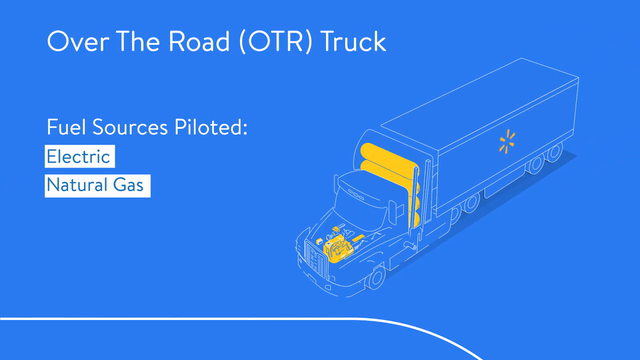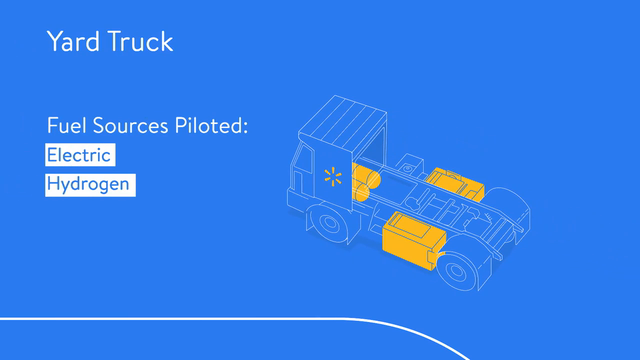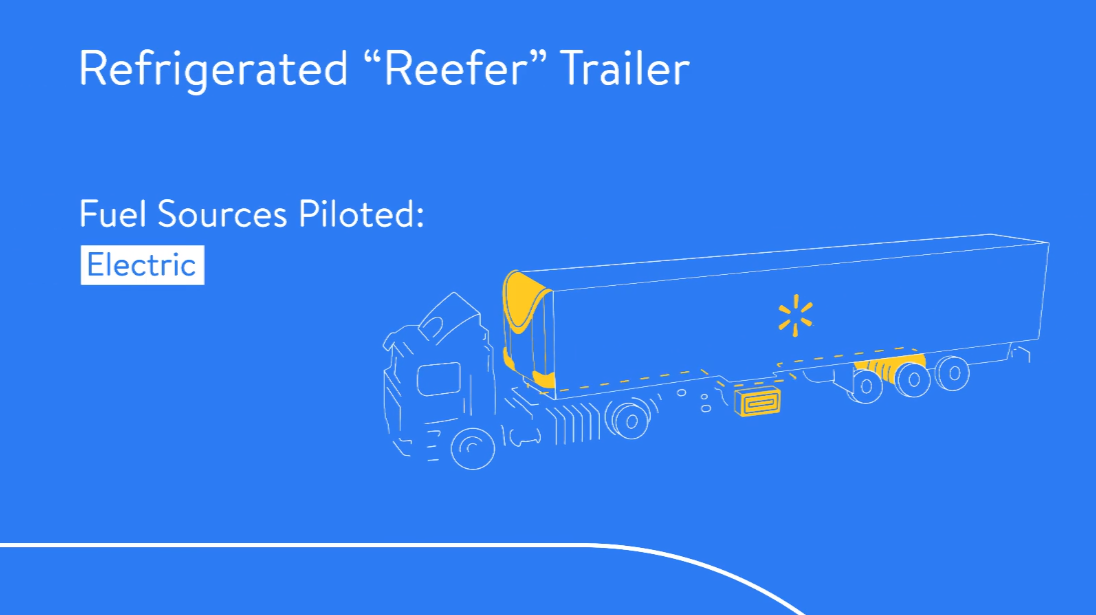Zero Sum: How Walmart Transportation Is Working To Reduce Emissions Now and in the Future
By Fernando Cortes, Senior Vice President, Transportation
Originally published by Walmart on June 8, 2022
As the world’s largest retailer, with a world-class transportation network, we have the ability to make a meaningful difference when it comes to reducing greenhouse gas emissions. That’s why in 2020, we set the goal to achieve zero emissions across Walmart's global operations by 2040.
This includes our last mile delivery fleet, an area that is uniquely positioned for innovative solutions. You’ve seen us be among the first to use 100% electric self-driving cars and class 3 trucks, electric delivery vans and even drones. But there’s another fleet we’re committed to transforming, one that will have an even bigger impact on achieving our zero emissions goal: our Class 8 transportation fleet.
We know transforming our transportation fleet is not as simple as flipping a switch, but that doesn’t mean we’re sitting idle. Today I’m excited to share more about our zero-emissions transportation strategy and announce a series of collaborations and pilots. Many of these initiatives are first-of-their kind for Walmart and will be pivotal in moving us towards a zero emissions future, while being instructive to the entire transportation industry.
A Meaningful Approach
Walmart operates one of the largest and safest fleets in the U.S., with 12,000 drivers, 10,000 tractors and 80,000 trailers driving 1.1 billion miles every year. With a fleet of this scale, it made up approximately 24% of our Scope 1 emissions in 2020.
To make a meaningful impact, we’re taking a meaningful approach by evaluating various attributes of three different fuel types – renewable natural gas, hydrogen and electric. We’re piloting solutions not only for our over-the-road (OTR) trucks but for refrigerated trailers (also known as reefers) and yard trucks (which move trailers around in the lots), too. Here is how we are layering solutions to determine the best recipe for building a Walmart that is regenerative in action.
Natural Gas
As we transition away from diesel and move towards a lower emissions fleet, we plan to deploy and evaluate vehicles powered by compressed natural gas (CNG). Natural gas engines have a comparable range to diesel engines of around 700 miles – which makes them a great potential fit for our sleeper cabs – and can produce tangible emissions benefits that compound whenever powered by renewable natural gas (RNG) or RNG-linked fuel.
Renewable natural gas is produced by capturing biomethane of decomposing matter and treating it to generate fuel. Uncaptured biomethane has up to 25 times the ability to trap heat in the atmosphere compared to CO2, but by capturing it from sources like dairy manure or food waste, studies suggest that renewable natural gas can avoid more emissions than it generates.
Over-the-Road: Starting early next year we’ll be the first transportation company to receive Cummins' new 15-liter Natural Gas Engine and will be adding them to a few of our trucks. This brand-new engine is expected to deliver the same power and torque of a 15-liter diesel engine but with significantly lower emissions, lighter-weight and overall lower cost per mile than its diesel counterpart. And to maximize the potential emissions benefits of utilizing this technology, we have secured agreements with Chevron to supply Walmart trucks with CNG linked to renewable natural gas.
With so many major players in the industry working together to find a solution, we are optimistic we can drive meaningful growth in the market with critical lessons to come from this pilot.
Hydrogen
While the use of hydrogen is still in early development, we’re excited to be among the first to adopt it in our fleet. In fact, we’re already transporting liquid hydrogen to fuel many of our forklifts across our grocery distribution centers.
The advantage of hydrogen is that, compared to battery-electric, it has a higher range of around 400 miles, takes significantly less time to refuel and weighs less, allowing us to haul more freight. The downside? Right now, it's expensive, and we know our customers look to us to keep prices low.
Yard Trucks: In just a few months, we’ll be the first company in the U.S. to test the capabilities and performance of Capacity’s very first second-generation hydrogen fuel cell yard truck. The truck is manufactured by Capacity in Longview, Texas, and has a range of expected benefits including an operating time of up to 10 hours on a single refuel, faster refuel time and less dependence on the electric charging grid. Plus, we can utilize the same infrastructure as our hydrogen forklifts while producing little to no emissions.
In fact, it’s because of these benefits that we see hydrogen as an option for our long-haul over the road tractors – will have more to share on that soon.
Electric
Finally, as electric vehicles become more mainstream, we’ve been exploring where they fit into Walmart’s fleet. Given the current weight and range capabilities of electric-battery trucks, they’re an attractive solution for yard operations, lighter weight hauls and day deliveries of around 200 miles – all of which play important roles in our operations.
Yard Trucks: We’ve been running zero emissions electric yard trucks, similar to Autocar’s all-electric terminal tractor (E-ACTT), in our distribution centers over the last year and have found they provide approximately a 50% emissions reduction compared to diesel trucks, taking into account how the electricity is created and delivered to power these units. Our goal is to continue working to pair these trucks with renewable energy like wind, solar, or hydro powers, so we can achieve a true 100% emission reduction.
Refrigerated Trailers: We also have an opportunity to power our refrigerated trailers with electric energy. As the world’s largest grocer, we use 10,000 of these refrigerated trailers to safely distribute fresh and cold groceries to stores. Today, they rely on diesel fuel to keep them cold, which contributes to our overall CO2 emissions.
To change this, we recently worked with Thermo King to haul Walmart’s first-ever refrigerated trailer operated on battery electricity in the U.S. The trailer is designed to run on 100% electricity until the batteries are fully depleted. If the electricity is depleted mid-haul, the refrigeration unit cuts over to diesel.
During the two-month trial, we ran 18 routes hauling groceries between our distribution center in Shafter, California, and stores in the surrounding areas. We’re pleased to share that throughout the entirety of the pilot, the trailer ran on electricity 83% of the time.
Over-the-Road: Finally, we can’t talk electric without talking over-the-road, specifically our day cabs. Later this summer, we aim to run a battery-electric day cab proof of concept with Freightliner’s eCascadia and Nikola’s Tre BEV out of a distribution center in Fontana, California. These electric day cabs will be picking up loads from suppliers and delivering them to a consolidation center in the area. Short-range deliveries such as these are a great use case for electric trucks, and we’re excited to be among the first to test them in our operations.
Moving the Industry Forward
Becoming a zero emissions company won’t be as simple as adopting electric alternatives. For some vehicle classes, the solution might look like a hydrogen-fueled yard truck moving an electric refrigerated trailer, which eventually gets transported by a natural gas-powered truck. Our hope is that by testing and learning, we can find the right recipe to reduce greenhouse gas emissions and create a less impactful transportation fleet, all while still delivering the freshest food and goods to our customers.
And while many of these technologies are still early stage, through industry collaboration, support from policymakers and actively testing alternative fuel-types in our transportation fleet, we hope to make a difference not only for Walmart’s operations but for the industry as a whole. Because we know when we lead, others follow.
As I look to the future, I’m confident that when you see a Walmart truck driving down the highway, you’ll be able to physically see us in action creating a better future for all of us – our children, our grandchildren and our planet.





